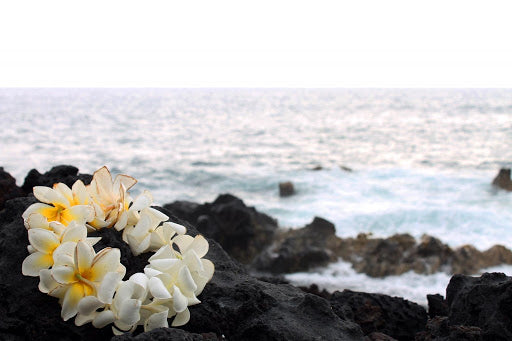
Why May Day is Lei Day
Share
More Than A Necklace: A Symbol of Aloha
The ‘lei’ as it’s known around the world, is the symbol of aloha. Hawaii is famous for adorning visitors with the iconic lei upon arrival, however the sharing and wearing of lei began long before that was a tradition. The first Hawaiians carried this custom with them from their Polynesian island homes to the shores of Hawaii.
The Seas of Hawaii
The lei represents the eight seas of Hawaii, and describes which flowers, colors, chiefs, seascapes and landscapes symbolize each mokupuni, or island. The mele soon after served as a guide to making lei representative of each of the mokupuni:
White: Niʻihau, “The Forbidden Isle,” and a lei made of pūpū (shells). Niʻihau is the only island represented by a shell, as its residents are famous for the intricate lei they craft out of shells that can only be found on that island.
Purple: Kauaʻi, “The Garden Isle,” and a lei made from the rare, anise-scented mokihana berry.
Yellow: Oʻahu, “The Gathering Place, and a lei of golden ʻilima flowers.
Green: Molokaʻi, “The Friendly Isle,” and a lei of polished kukui (candlenuts).
Orange: Lānaʻi, “The Pineapple Island,” (because of the island’s long history as a pineapple plantation) and a lei of kaunaʻoa, a native, leafless vine.
Gray: Kahoʻolawe, “The Target Island,” (the uninhabited island was used by U.S. Armed Forces for live-fire training and test explosions for decades), and a lei of hinahina, a native, silvery heliotrope that grows on the beach.
Pink: Maui, “The Valley Isle,” and a lei of lokelani (a small rose).
Red: The island of Hawaiʻi, “The Big Island,” and lei of ʻōhiʻa lehua, a native honey plant. The red ʻōhiʻa lehua is often the first shrub that will sprout from a recent lava flow.
Lei Carry The Mana
Although it seems lei are commonly given out, each lei still holds a special meaning. When we reminisce about the occasions our Ohana has celebrated, we also remember the people who were present. Lei carry the mana, or spirit, of their makers and when sharing a lei with someone else, the mana is passed onto them. Placing a lei on someone is considered a symbolic embrace letting the recipient know that they are respected and loved. To refuse a lei or to remove it right away is considered impolite because it stops the flow of the gift. So ideally, lei should be returned to where they originated. Therefore, many people drape lei over a tree branch when they are done with it, so when the petals fall they feed the earth.
A Slipper Inspired By Our Heritage
These traditions and memories fused our inspiration for our newest slipper #4120 Kalakoa (mokupuni). So as we celebrate this special “May Day is Lei Day in Hawaii Nei”, we are beyond stoked to introduce our latest design.

And honor connecting two different aspects of our life: our heritage that is Hawai’i and our passion for making quality slippers.
Spread Aloha To The World.
- Kaione Scott
